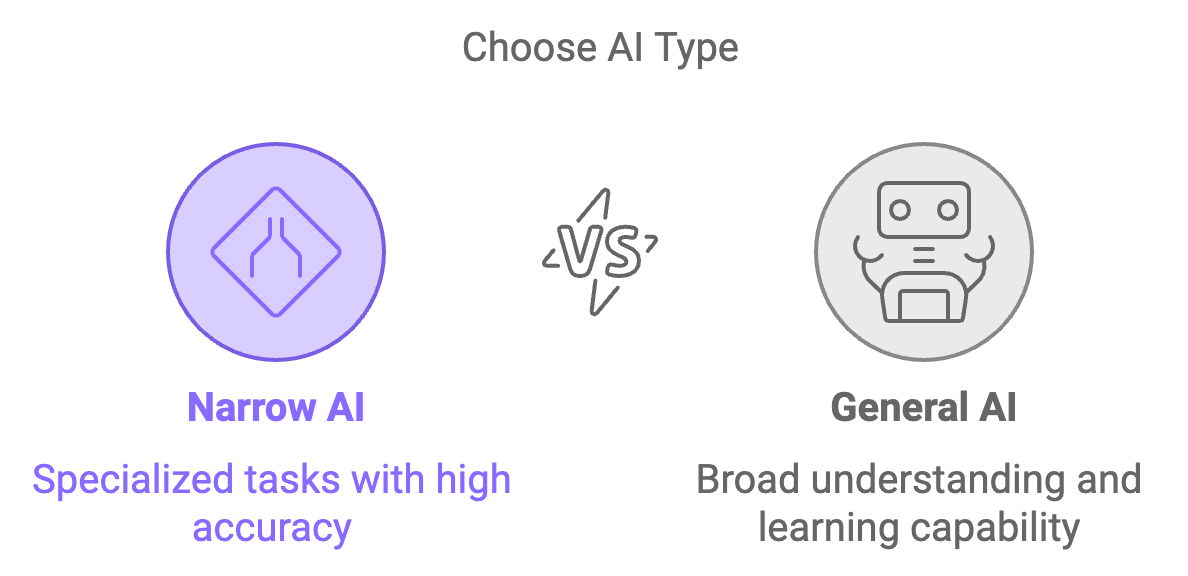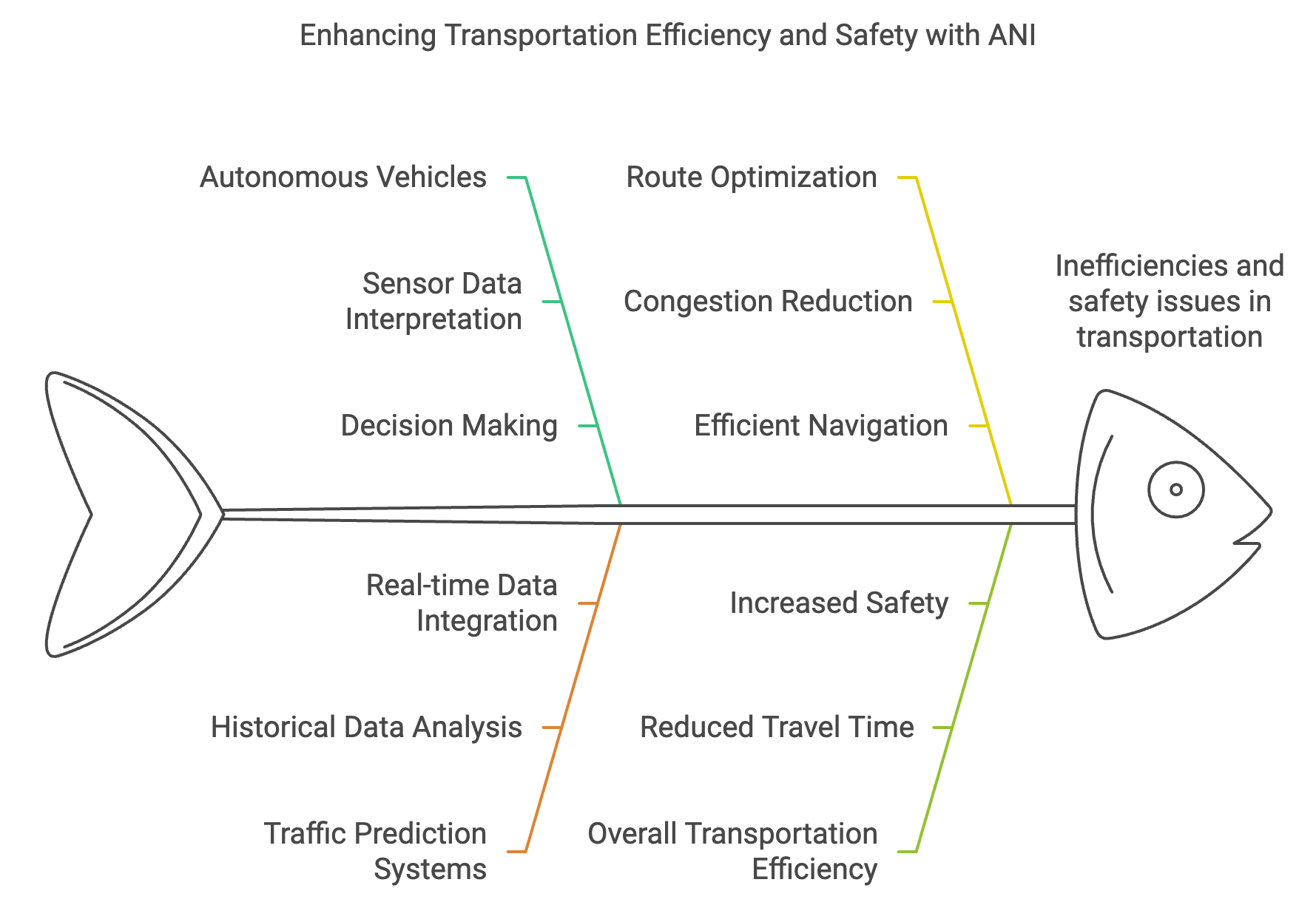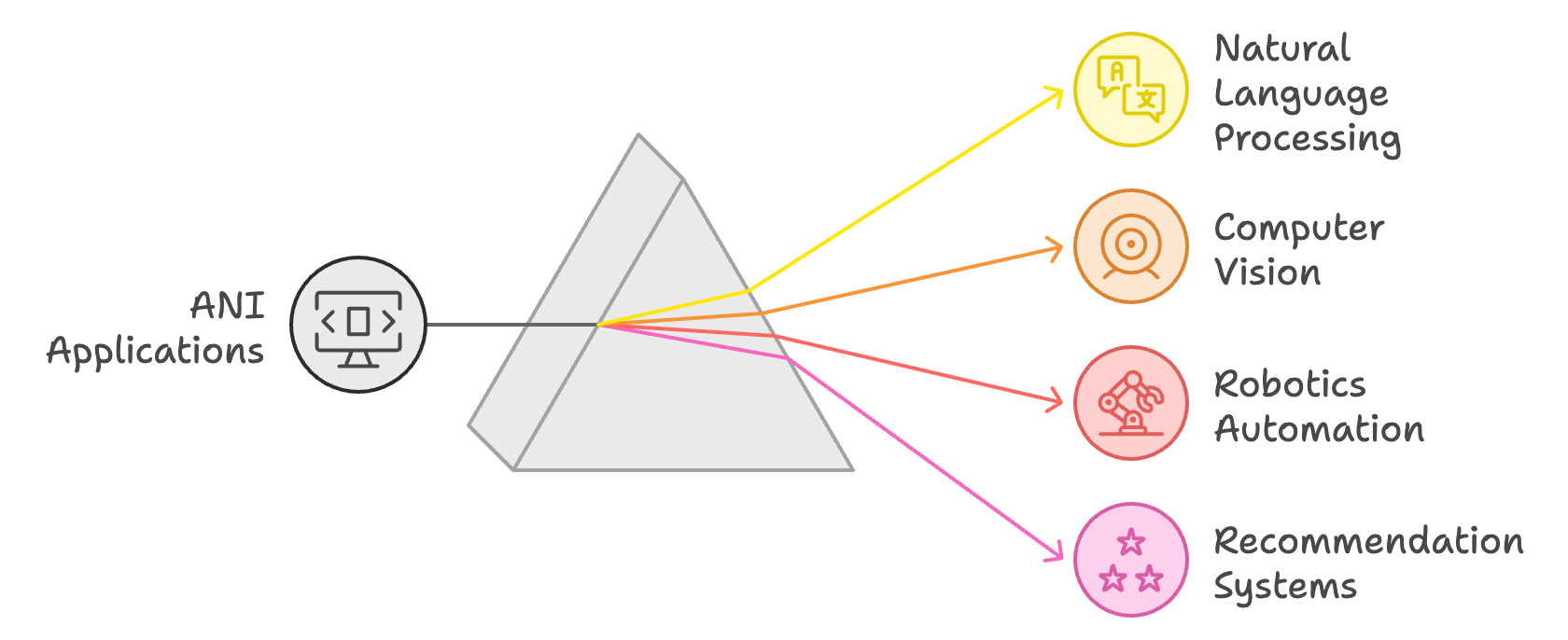Breaking Down Artificial Narrow Intelligence

Artificial Narrow Intelligence (ANI) is reshaping the way we work and interact with machines. This article unpacks the fundamentals of ANI, highlighting how it differs from other forms of artificial intelligence, showcasing real-world applications, and outlining scenarios where general AI might offer broader benefits. By the end, you’ll gain a clear understanding of ANI's capabilities and its transformative role across industries.
Key Insights
- What is ANI?
ANI refers to AI systems designed to excel in specific tasks, mimicking human intelligence within a defined scope. - Why focus on ANI?
Its strength lies in precision and efficiency, making it ideal for repetitive, data-driven tasks. - How is ANI different from General AI?
Often called "weak AI," ANI lacks self-awareness and generalized problem-solving capabilities, unlike the broader, more ambitious goals of general AI. - Where is ANI being used?
From diagnosing diseases in healthcare to streamlining financial operations and optimizing transportation systems, ANI is making a tangible impact.
Let’s explore these aspects further to see how ANI is shaping the future of technology and its integration into our daily lives.
What is Artificial Narrow Intelligence (ANI)?
Artificial Narrow Intelligence (ANI), often called weak AI, refers to computer systems designed to perform specific tasks with human-like precision and adaptability—limited to a defined domain. Unlike general AI, which aims to replicate human intelligence across various tasks, ANI excels in routine, data-driven operations that require high accuracy and efficiency. Its specialization makes it highly effective within its scope but incapable of generalizing knowledge to other areas.
ANI relies heavily on structured data and specialized algorithms to perform its tasks. By processing well-organized datasets and leveraging advanced computational models, ANI systems can achieve remarkable accuracy and efficiency in specific domains.
The Building Blocks of ANI
Machine Learning: The Foundation of ANI
Machine learning drives ANI by enabling systems to learn from data and improve performance over time. Key machine learning approaches include:
- Supervised Learning: Systems are trained on labeled datasets, learning to classify data or predict outcomes. For instance, supervised learning is crucial in applications like medical diagnosis or fraud detection.
- Unsupervised Learning: ANI identifies patterns and relationships within unlabeled data, useful in clustering tasks such as market segmentation.
- Reinforcement Learning: ANI learns optimal strategies through a system of rewards and penalties, making it invaluable in robotics and decision-making tasks.
Deep Learning: Unlocking Complex Data Analysis
Deep learning, a subset of machine learning, uses artificial neural networks inspired by the human brain to process complex datasets. These networks can:
- Recognize objects in images (e.g., facial recognition).
- Understand spoken language (e.g., speech-to-text systems).
- Generate insights from large volumes of unstructured data.
Deep learning thrives on high-quality structured and unstructured data, requiring extensive computational resources to train and optimize models effectively.
Natural Language Processing (NLP): Bridging the Human-Machine Gap
NLP is essential for enabling ANI to understand and generate human language. By analyzing structured data like linguistic patterns and syntactic rules, NLP-powered systems can:
- Interpret commands and questions.
- Generate conversational responses.
- Extract key information from documents.
Other supporting technologies like expert systems and rule-based AI provide the logic and decision-making frameworks for ANI in domains requiring specialized expertise.
Technical Mechanisms of Artificial Narrow Intelligence
ANI’s effectiveness hinges on its ability to process structured data using specific algorithms:
Data Preprocessing: ANI systems rely on clean, well-organized datasets, such as numerical records, annotated images, or transcribed text, to train models.
Feature Engineering: Key patterns and relationships are extracted from data to improve model accuracy.
Algorithm Selection: Depending on the task, ANI systems employ algorithms like:
Decision Trees: For tasks like credit scoring or diagnostic tools.
Support Vector Machines: For classification problems, such as spam detection.
Convolutional Neural Networks (CNNs): For image recognition and analysis.
Recurrent Neural Networks (RNNs): For sequential tasks like language modeling or time-series predictions.
These mechanisms ensure ANI systems are finely tuned to their designated tasks, maximizing performance and reliability.
The Future of ANI and Ethical and Developmental Considerations
As ANI continues to evolve, advancements in cognitive computing, machine consciousness, and hybrid AI models may blur the lines between ANI and Artificial General Intelligence (AGI). While AGI remains theoretical, ANI systems’ reliance on structured data and task-specific algorithms could serve as stepping stones toward broader capabilities.
At the same time, ethical considerations such as algorithmic bias, transparency, and data privacy will shape the trajectory of ANI. Ensuring fairness and accountability in AI deployment will be critical as ANI becomes increasingly embedded in daily life.
Everyday Examples of ANI in Action
ANI is already driving transformative applications across industries:
- Virtual Assistants: Siri, Alexa, and Google Assistant process voice commands and provide contextual responses.
- Predictive Maintenance: ANI analyzes sensor data to forecast equipment failures, optimizing industrial operations.
- Image Recognition: Facial recognition systems and visual search applications identify objects, patterns, and features in visual data.
These examples demonstrate ANI’s reliance on structured data and sophisticated algorithms, highlighting its potential to revolutionize both personal and professional environments.
This version deepens the technical focus, incorporating details on structured data, preprocessing, and specific algorithms while maintaining a clear and engaging narrative. Let me know if further refinements are needed!

How General Intelligence Works
While general intelligence aims to mirror the breadth and adaptability of human cognition, most of today’s AI systems operate on the principle of Artificial Narrow Intelligence (ANI). Narrow AI excels within tightly defined parameters, offering clear benefits but also notable constraints.
Advantages of Narrow AI
Narrow AI systems provide significant boosts to efficiency, accuracy, and productivity. They can process and analyze massive amounts of data faster than any human, enabling cost reductions and enhanced output in sectors like manufacturing and data analytics. By handling repetitive, time-consuming tasks, these systems free human workers to focus on strategic thinking, creativity, and innovation.
Limitations of Narrow AI
Despite its strengths, narrow AI cannot generalize beyond its designated tasks. It lacks common sense, intuitive judgment, and the ability to adapt to unfamiliar situations—qualities central to the notion of general intelligence. This limitation confines its usefulness, preventing ANI from tackling new domains without extensive retraining or reprogramming.
Economic and Ethical Considerations
As ANI becomes more capable, it may automate certain jobs that rely on routine tasks, potentially causing workforce displacement. Addressing this issue requires proactive strategies: reskilling workers, creating new roles that leverage human creativity, and ensuring a smooth transition to AI-enhanced operations.
Ethical concerns also arise, particularly around algorithmic bias and privacy. Biased training data can yield skewed outcomes, while data collection practices must respect individual rights and maintain public trust. Effective oversight, transparency, and regulatory frameworks are essential to ensure the responsible use of narrow AI.
Balancing Advantages and Drawbacks
In many scenarios, the benefits of narrow AI—improved productivity, heightened efficiency, and better-informed decision-making—outweigh its downsides. However, these systems underscore what general intelligence aspires to achieve: adaptability, context-awareness, and the capacity to learn and reason autonomously. By understanding narrow AI’s current capabilities and limitations, we gain a clearer vision of what general AI could ultimately become.
Some definitions:
AI researcher, software dev, or human interaction specialist who understands the inner workings of an AI model.
AI development, the process of building and training AI models
superintelligence, a hypothetical agent that possesses intelligence far surpassing that of the brightest and most gifted human minds
AI models, the building blocks of AI tools such as chatbots like ChatGPT
types of AI, weak AI, and strong AI, these are types of artificial superintelligence systems

Examples of Artificial Narrow Intelligence
Artificial Narrow Intelligence (ANI) has revolutionized numerous industries, reshaping business operations and enhancing the services they deliver. Here are some real-world applications of narrow AI:
Healthcare
ANI is transforming healthcare through tasks like disease diagnosis, medical image analysis, and personalized treatment planning. For example, AI algorithms equipped with narrow intelligence can detect cancerous lesions in medical images with remarkable precision, facilitating early intervention and improved patient outcomes. Additionally, ANI-powered tools analyze patient data to assist healthcare professionals in creating tailored treatment plans, optimizing care efficiency and effectiveness.
Finance
Financial institutions leverage ANI to bolster fraud detection, streamline trading, and enhance customer service. Fraud detection systems use ANI to process vast datasets in real time, spotting anomalies and patterns indicative of fraudulent activities. In algorithmic trading, ANI processes complex market data, making rapid investment decisions and executing trades with unmatched precision. ANI-powered chatbots and virtual assistants further improve customer experiences by automating routine inquiries and transactions.
These examples demonstrate ANI's capacity to address specific challenges with accuracy and efficiency, driving advancements across sectors. By continuing to adopt and refine narrow AI, industries can unlock new levels of performance and innovation.
Transportation companies are another sector where narrow AI has made a significant impact. ANI is utilized in autonomous vehicles to enable safe and efficient self-driving capabilities. These vehicles utilize ANI algorithms to interpret real-time sensor data, make decisions, and navigate complex road conditions. ANI is also employed in traffic prediction systems, which use historical and real-time data to optimize routes and reduce congestion, improving overall transportation efficiency.



Future of Artificial Narrow Intelligence
The future of Artificial Narrow Intelligence (ANI) is rich with possibilities, offering the potential to transform industries and redefine how we approach problem-solving. Here’s a look at some key predictions and possibilities that could shape the path forward for narrow AI.
Predictive Analytics and Intelligent Automation
ANI’s ability to analyze vast datasets will drive advancements in predictive analytics and intelligent automation. This integration is set to revolutionize sectors like healthcare, finance, and manufacturing. For example:
- Healthcare: Predictive analytics can aid in disease prevention and create personalized treatment plans tailored to individual needs.
- Finance: Advanced models can detect fraud and optimize investment strategies in real time.
- Manufacturing: Intelligent automation can streamline operations, enhance efficiency, and support data-driven decision-making.
The Convergence of Narrow and General AI
Ongoing research in general AI may gradually blur the lines between ANI and AGI (Artificial General Intelligence). While ANI excels in specific tasks, the pursuit of AGI focuses on creating systems with human-like adaptability and understanding. Advances in cognitive computing, natural language understanding, and machine consciousness may bring about hybrid AI systems, bridging the gap between narrow specialization and general intelligence.
Ethical Considerations and Responsible AI
As ANI continues to integrate into our daily lives, ensuring ethical and responsible development will be paramount. Addressing concerns around biases, fairness, transparency, and accountability will foster trust in AI systems. Regulations and standards will play a critical role in:
- Minimizing algorithmic biases.
- Protecting individual privacy.
- Encouraging equitable access to AI technologies.
Opportunities and Challenges Ahead
While ANI offers tremendous advantages in efficiency, accuracy, and productivity, challenges remain. These include:
- Limited ability to generalize knowledge across domains.
- Potential job displacement due to automation.
- Privacy concerns tied to data usage.
- The risk of perpetuating biases through flawed training data.
Despite these challenges, ANI’s future holds immense promise. By adopting responsible AI practices and fostering innovation, narrow AI is poised to deliver groundbreaking advancements across multiple domains.
Frequently Asked Questions
What is artificial narrow intelligence examples?
Artificial narrow intelligence examples are systems that are designed to perform a specific task or set of tasks proficiently. These systems are focused on one narrow function, such as image recognition or language translation.
What is an example of ANI?
An example of artificial narrow intelligence (ANI) is Google's search engine. It is designed to perform one specific function well, for information on the internet based on keywords.
What is narrow vs Weak AI?
Narrow AI, also known as weak AI, refers to systems limited to a narrow set of tasks and functions. These systems excel at specific tasks but cannot perform many functions or think for themselves like humans.
Is ChatGPT an artificial narrow intelligence?
Yes, ChatGPT can be considered an artificial narrow intelligence. It is designed to generate human-like text responses based on user input. While it can carry on conversations and provide information on several topics, its capabilities are limited to text-based interactions.




